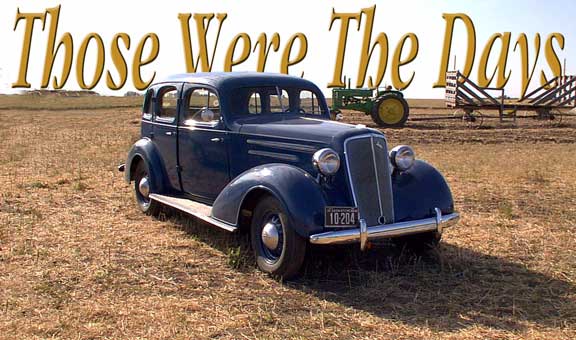 |
| FTLComm - Tisdale - September 17, 2000 |
 How my uncles would have shook their heads in wonder at people coming out to watch grain being threshed. As I grew up in the early fifties most farmers were still relying upon thrashing machines and the technology that came from the prewar era for harvesting grain. Certainly some farmers in our area of Southeastern Saskatchewan had pull type combines but the labour intensive but traditional method of harvesting was still using a set up like that which you see in this picture. |
| The difference I see was that in the early fifties tractors were used to drive the belt for the threshing machine and pull the binder but picking up the stooks in the field was done with horse drawn racks. Uncle Karl's May and June would move along the rows with a "glick, glick glick" , "haw" would swing the rack around to the left and "geeee" would bring them and the rack around to the right. "Whoa" stopped the process and then any other conversation or song would add to the |
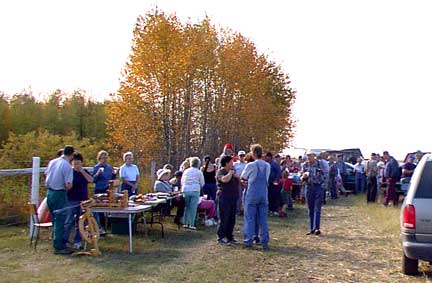 process. process.Tractors pulling racks was something that I had seen in the late fifties used by some small farms but I can not recall being involved in that means of picking up the wheat sheaves About eight miles South of Tisdale a piece of field by the highway had been cut with a binder, the sheaves piled into stooks and on Saturday it was time to thresh the wheat. People from all around gathered to watch and talk about the way it used to be done, with the smell of coffee and grain dust in the air, the autumn sun and gentle breeze was an appetiser to a flood of memories. |
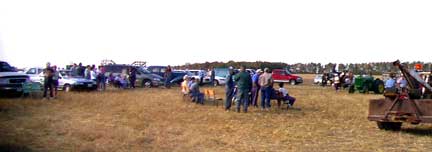 Those were the days, days long ago when the whole extended family got together and went from farm to farm to get the year's crop off. I remember the hot days, the cold days and the damp days, but mostly I remember more sandwiches then I could eat, and pie. Pie, pie and more pie, apple, raisin, lemon, saskatoon, blueberry peach, rhubarb and talk of politics, |
| grain prices, the neighbours and that damn belt. Yeah there was always talk about that damn belt as the tractor would crank up the clattering threshing machine which was designed to shred itself as it jumped this way and that, then there would be a whack of a broken drive belt, the tractor shutting down and some profound discussions that used words that if I repeated would result in definite sanctions, filled the air. |
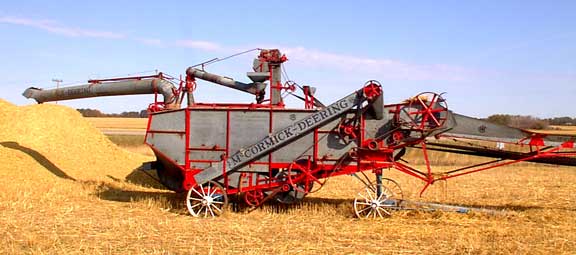 |
| The broken end was trimmed, special tools taken out of tool box at the back of the machine and carefully leather strips were used to sew end to end, finally ready it was ready to attempt to restart. Slipped on the pulley, everyone clear, the tractor clutch released and the belt would begin to sing followed by the crazy clatter of the threshing machine and a 50% chance that the belt would go sailing off toward the thresher followed by more comments about that "Gawdamn Belt". |
|
|
| This little McCormick Deering threshing machine was tiny beside some of those that smashed themselves to bits separating the wheat from the chaff. I remember wooden ones, and great big galvanised ones that most of my uncles called "separators". The machines themselves were always taken care of by one member of the team who set the "concave" and adjusted the pulleys and prayed that the belt would make it through this year's harvest. |
 |
| In the field hauling in the sheaves were two absolutely immaculate John Deere specimens.
The "A" on the left with a wide set of wheels on the front is a version
of one of the most successful tractors ever, the so-called tricycle "A".
Farm tractors of the post war era were of two varieties, small and small utility. The regular field machines of the era were International "W4", its larger cousin the "W6", and there were "WD" versions of both ("D" for diesel), Massey Harris 44s were the glamour machines, lower in power but easy to maintain, and the John Deere "R" and "AR" of which the tractor above right is a superior example. The utility tractors of the 50s were the John Deere tricycle "A" and almost every farm seemed to have an International Model "M" in either a tricycle or wide wheeled version. Some farms had Case or Allis-Chambers but those were far less common. The low cost and extremely reliable Massey and John Deere machines were by far the majority. Farmers liked the slightly more complicated but slightly more expensive International tractors which was the new name for McCormick Deering. |
 |
| This exceptional tractor pulling a discer is extremely rare and looks like it just
rolled out of a factory. It is an early fifties diesel and I have no other background
to tell you other than it is likely that this is a European tractor. Ken Bob Service and Salvage South of Tisdale has developed a remarkable collection of vintage tractors and farm implements. Unlike many such collections one finds in Saskatchewan. this one has each machine restored to its original condition. and such remarkable attention to detail makes them absolute show pieces. |
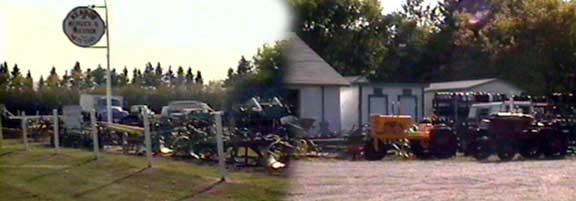 |
| Sitting amidst the folks watching the demonstration were two superior vintage cars each of these can be seen on pages of their own. A 1935 Master Chev and a Ford Model "A" that is one of the best you would ever see. |
